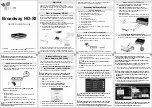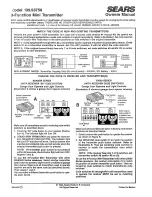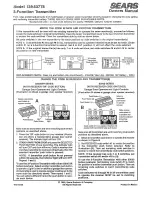
167
14
SET MODE
External Keypad
54.
(Default: OFF)
Turn the external keypad ON or OFF for keyer mem-
ory transmission.
See page 26 for the equivalent circuit of an external
keypad and connection.
• OFF
: The external keypad does not func
-
tion.
• KEYER SEND : In the CW mode, pushing one of ex
-
ternal keypad switches transmits the
desired keyer memory contents.
USB Audio SQL
55.
(Default: OFF(OPEN))
Select whether or not to output the audio from the
[USB] connector on the rear panel, according to the
squelch state.
The same audio signals are sent from the [USB] con-
nector and the [ACC] sockets.
- The beep tones and the voice synthesizer announce-
ments are not sent.
- The received audio output level cannot be adjusted
with the [AF] control.
• OFF (OPEN) : The received audio is always sent,
regardless of the squelch state.
• ON
: The received audio is sent when the
squelch is open.
USB MOD Level
56.
(Default: 50%)
Set the input modulation level of the [USB] connector
to between 0% and 100% in 1% steps.
9600bps Mode
57.
(Default: OFF)
Turn the [DATA2] socket’s 9600 bps data transmission
ON or OFF.
• OFF : For only the regular audio (or slow data) trans
-
mission.
• ON : For 9600 bps data transmission.
DATA OFF MOD
58.
(Default: MIC,ACC)
Select the desired connector(s) for data modulation
input in the data OFF mode.
• MIC
: Use the signals from [MIC].
• ACC
: Use the signals from [ACC] (pin 11).
• MIC, ACC : Use the signals from [MIC] and [ACC]
(pin 11).
• USB
: Use the signals from [USB].
DATA MOD
59.
(Default: ACC)
Select the desired connector(s) for data modulation
input in the data mode.
• MIC
: Use the signals from [MIC].
• ACC
: Use the signals from [ACC] (pin 11).
• MIC, ACC : Use the signals from [MIC] and [ACC]
(pin 11).
• USB
: Use the signals from [USB].
CI-V Baud Rate
60.
(Default: Auto)
Set the CI-V data transfer rate between 300, 1200,
4800, 9600, 19200 bps and “Auto.”
When “Auto” is selected, the baud rate is automatically
set according to the data rate of the connected con-
troller.
CI-V Address
61.
(Default: 7Ch)
To distinguish equipment, each CI-V transceiver has
its own Icom standard address in hexadecimal code.
The IC-9100’s address is 7Ch.
When 2 or more IC-9100’s are connected to an op-
tional CT-17
ci
-
v
level converter, rotate [MAIN DIAL] to
select a different address for each IC-9100; the range
is 01h to DFh.
CI-V Transceive
62.
(Default: ON)
Turn the transceive function using the CI-V system ON
or OFF.
When this item is set to ON, changing the frequency,
operating mode, etc. on the IC-9100 automatically
changes those settings on other Icom transceivers or
receivers, and vice versa.
• OFF : Transceive function OFF
• ON : Transceive function ON
USB2/DATA1 Func
63.
(Default: [-----]/GPS)
Two COM port numbers are assigned to the [USB]
connector. One of them is “USB1,” used for cloning
and CI-V operation. The other one is “USB2,” and the
function is selected by this item.
•
----- : “USB2” is not used.
• RTTY : Used to send RTTY decoded signals.
• DVdat : Used for low-speed data input and output.
• If you set the function of the [DATA1] jack to
“GPS,” and “DATA1
➔
USB2” is selected as
the “GPS Out” item’s option, as described
below, “USB2” will be used for the low-speed
data input and GPS data output.
■
Set mode description (Continued)
















































